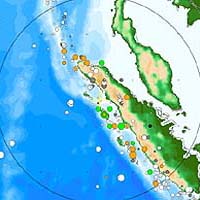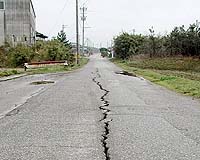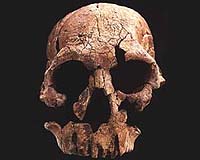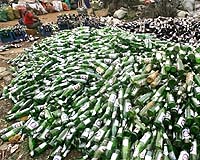| March 26, 2007 |  |
life as we know it |
|
The Next Great Earthquake Troy NY (SPX) Mar 26, 2007  The 2004 Sumatra-Andaman earthquake and resulting tsunami are now infamous for the damage they caused, but at the time many scientists believed this area was unlikely to create a quake of such magnitude. In the March 23 issue of the journal Science, a geophysicist from Rensselaer Polytechnic Institute urges the public and policy makers to consider all subduction-type tectonic boundaries to be "locked, loaded, and dangerous. Seismologists have long tried to determine which subduction boundaries are more likely than others to break," says Robert McCaffrey, professor of earth and environmental sciences at Rensselaer... read more
The 2004 Sumatra-Andaman earthquake and resulting tsunami are now infamous for the damage they caused, but at the time many scientists believed this area was unlikely to create a quake of such magnitude. In the March 23 issue of the journal Science, a geophysicist from Rensselaer Polytechnic Institute urges the public and policy makers to consider all subduction-type tectonic boundaries to be "locked, loaded, and dangerous. Seismologists have long tried to determine which subduction boundaries are more likely than others to break," says Robert McCaffrey, professor of earth and environmental sciences at Rensselaer... read more |
Japan's worst wildfire in half a century spreads
Thai court accepts invasive fish case against food giant Rare tropical cyclone swirls off eastern Australia Indonesia plans $40 bn energy projects in 2025: minister Plan B: Pakistan beekeepers widen pursuit of flowers UN says new plastics pollution talks set for August EU proposes emission rule delay to spare carmakers from fines EU chief offers carmakers more time on emission rules to avoid fines Swedish police open 'sabotage' probe over Gotland water supply damage Paris imposes car-sharing lane on congested ring road
|
|
| Previous Issues | Mar 23 | Mar 22 | Mar 21 | Mar 20 | Mar 19 |
New Evidence Puts Snowball Earth Theory Out In The Cold LOndon UK (SPX) Mar 26, 2007
LOndon UK (SPX) Mar 26, 2007The theory that Earth once underwent a prolonged time of extreme global freezing has been dealt a blow by new evidence that periods of warmth occurred during this so-called 'Snowball Earth' era. Analyses of glacial sedimentary rocks in Oman, published online today in Geology, have produced clear evidence of hot-cold cycles in the Cryogenian period, roughly 850-544 million years ago. The UK ... more Microfossils Unravel Climate History Of Tropical Africa  Amsterdam, Holland (SPX) Mar 26, 2007
Amsterdam, Holland (SPX) Mar 26, 2007Scientists from the NIOZ Royal Netherlands Institute for Sea Research obtained for the first time a detailed temperature record for tropical central Africa over the past 25,000 years. They did this in cooperation with a German colleague from the University of Bremen, The scientists developed an entirely new method to reconstruct the history of land temperatures based on the molecular fossi ... more Test Finds Manufactured Nanoparticles Don't Harm Soil Ecology  West Lafayette IN (SPX) Mar 26, 2007
West Lafayette IN (SPX) Mar 26, 2007The first published study on the environmental impact of manufactured nanoparticles on ordinary soil showed no negative effects, which is contrary to concerns voiced by some that the microscopic particles could be harmful to organisms. Scientists added both dry and water-based forms of manufactured fullerenes - nanosized particles also known as buckyballs - to soil. The nanoparticles didn't change how the soil and its microorganisms functioned, said Ron Turco, a Purdue University soil and environmental microbiologist... more MORE HEADLINES |
disaster-management:
 human:  pollution:  |
| Previous Issues | Mar 23 | Mar 22 | Mar 21 | Mar 20 | Mar 19 |
| The contents herein, unless otherwise known to be public domain, are Copyright 1995-2007 - SpaceDaily. AFP and UPI Wire Stories are copyright Agence France-Presse and United Press International. ESA Portal Reports are copyright European Space Agency. All NASA sourced material is public domain. Additional copyrights may apply in whole or part to other bona fide parties. Advertising does not imply endorsement, agreement or approval of any opinions, statements or information provided by SpaceDaily on any web page published or hosted by SpaceDaily. Privacy statement |